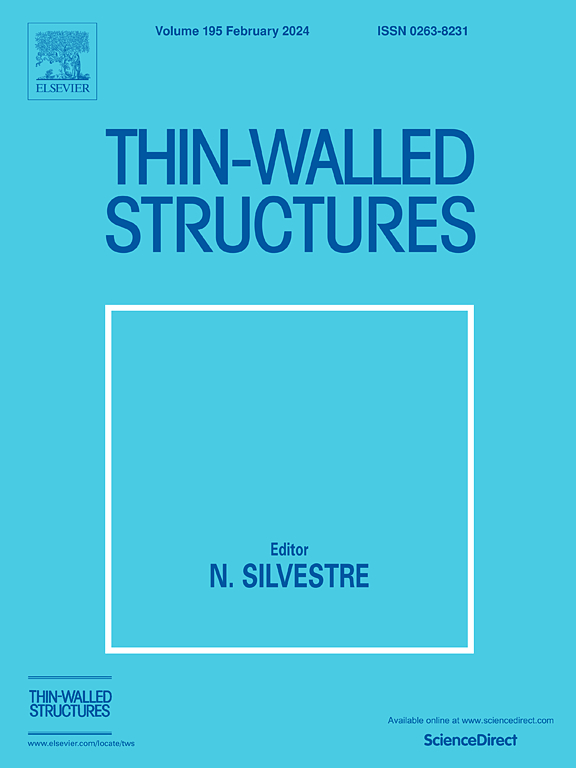耦合晶体取向对单晶超合金冷却涡轮叶片振动特性影响的系统研究
IF 5.7
1区 工程技术
Q1 ENGINEERING, CIVIL
引用次数: 0
摘要
涡轮叶片是航空发动机最重要的热部件之一,揭示振动特性的分散机制对其意义重大。因此,本文旨在通过理论分析与有限元数值计算相结合的方法,系统地探讨一次取向和二次取向偏差对单晶叶片动态响应的影响。此外,本文还通过数学方法阐明了工程学和材料科学中晶体取向之间的关系。通过 Laue 方法测量的三个角度定义了以两个偏差角(每个偏差角有 16 个方向)为特征的主取向和以 11 个偏差角为特征的次取向。理论分析和数值计算在第一弯曲或扭转模式的结构特征频率变化方面取得了良好的一致。数值结果表明,主方位偏差方向会导致低阶和高阶模态固有频率的显著分散。偏差角度的增大会扩大频散,扭转模态的最大变异比为 5.62%。重要的是,与二次定向的结合可进一步改变固有频率的离散性,扭转模态的最大变化率为 6.5%。这项研究为大幅提高单晶涡轮叶片的共振裕度提供了新的视角,具有防止高循环疲劳失效的潜在应用价值,对指导航空发动机的设计意义重大。本文章由计算机程序翻译,如有差异,请以英文原文为准。
A systematical investigation on the impact of coupling crystal orientations on vibration characteristics of a single crystal superalloy cooling turbine blade
Revealing the dispersion mechanism of vibration characteristic is significant for turbine blade that is one of the most important hot components of aero-engine. Thus, the aim of this article is to systematically address the influence of primary and secondary orientation deviations on the dynamic responses of a single crystal blade by theoretical analysis in combination with finite element numerical calculation. Besides, the relationship between the crystal orientation in engineering and material science is clarified by a mathematical approach. Primary orientations characterized by two deviation angles, each having 16 directions and secondary orientations with 11 deviation angles are defined by three angles measured by the Laue method. Good agreement on variation of structural eigenfrequency for the first bending or torsional mode is attained between theory analysis and numerical calculation. Numerical results show that the primary orientation deviation direction could cause significant dispersion of the natural frequencies for low and high order modes. The increasing deviation angle widens the dispersion, with the maximum variation ratio of 5.62% for the torsional mode. Importantly, the conjunction with the secondary orientation could further changes the dispersion of the natural frequencies, and the maximum variation of 6.5% is achieved for the torsional mode. This research may provide new perspectives for substantially improving the resonance margin of single crystal turbine blades, with potential applications in preventing high cycle fatigue failure, which is very meaningful to guide the design of the aero-engine.
求助全文
通过发布文献求助,成功后即可免费获取论文全文。
去求助
来源期刊

Thin-Walled Structures
工程技术-工程:土木
CiteScore
9.60
自引率
20.30%
发文量
801
审稿时长
66 days
期刊介绍:
Thin-walled structures comprises an important and growing proportion of engineering construction with areas of application becoming increasingly diverse, ranging from aircraft, bridges, ships and oil rigs to storage vessels, industrial buildings and warehouses.
Many factors, including cost and weight economy, new materials and processes and the growth of powerful methods of analysis have contributed to this growth, and led to the need for a journal which concentrates specifically on structures in which problems arise due to the thinness of the walls. This field includes cold– formed sections, plate and shell structures, reinforced plastics structures and aluminium structures, and is of importance in many branches of engineering.
The primary criterion for consideration of papers in Thin–Walled Structures is that they must be concerned with thin–walled structures or the basic problems inherent in thin–walled structures. Provided this criterion is satisfied no restriction is placed on the type of construction, material or field of application. Papers on theory, experiment, design, etc., are published and it is expected that many papers will contain aspects of all three.
 求助内容:
求助内容: 应助结果提醒方式:
应助结果提醒方式:


